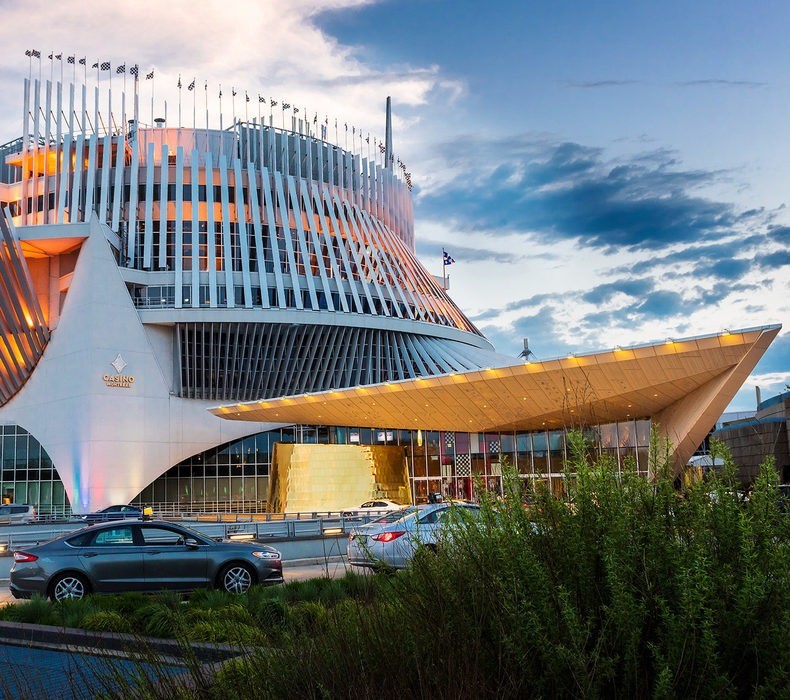An 8-Story Concrete and Steel Architectural Evolution in Canada Turns Into a Casino From Expo 67 Pavilions

Situated on Notre Dame Island within the scenic Jean-Drapeau Park, the Casino de Montréal stands as a premier Canadian casino and a remarkable architectural transformation. Owned and operated by the Société des casinos du Québec, a subsidiary of Loto-Québec, this expansive establishment occupies a site with a rich history - the pavilion buildings of Expo 67.
The first World Exposition in 1851 set the stage for a global tradition that reached its pinnacle in 1967 when Montréal hosted Expo 67, commemorating Canada's centennial. Designed by architects Jean Faugeron and Andre Blouin, the France Pavilion emerged as a grand structure with eight stories, crafted from concrete and steel, adorned with tall aluminum fins.
In stark contrast, the Québec Pavilion, designed by Swiss architect Gustave Maeder, embraced an avant-garde minimalist approach. Surrounded by water and accessible through a footbridge, its straight lines and glass walls challenged traditional architectural norms in the region.
Following Expo 67's success, the pavilions faced an uncertain fate. While many structures succumbed to demolition between 1985 and 1987, the interconnected France and Québec pavilions endured. In 1993, the former French pavilion underwent significant renovations, shedding its previous identity to become the inaugural casino for the province.
Renovations and Redesigns
The 1993 transformation involved meticulous renovations, addressing structural concerns, and updating the building's infrastructure. Asbestos removal, material substitutions, and the installation of modern systems were pivotal during this phase. The goal was to align the structure with contemporary standards and safety protocols while preserving its historical significance.
The journey of reinvention continued in 2013 when architects Menkès Shooner Dagenais LeTourneux Architects and interior designers Provencher_Roy collaborated on another redesign commissioned by Loto-Québec. This phase aimed to enhance exterior and interior spaces, ensuring a harmonious blend of modern functionality and respect for the original character.
The redesigned pavilion, now the Casino de Montréal, garnered architectural accolades, including the 2014 Grands Prix du Design awards. The project's success lay in its ability to modernize without compromising the historical essence of the former French pavilion. Streamlined entrances, a vibrant interior redesign, and a cohesive integration of recreational and gaming areas marked this transformative phase.
Casino de Montréal Today - A Hub of Entertainment and Culture
Today, the Casino de Montréal stands as a symbol of architectural adaptability and cultural preservation. It is located on Avenue du Casino and boasts over 500,000 square feet of gaming floor space, making it Canada's most prominent gambling establishment. With more than 3,200 electronic games and approximately 115 table games, the casino offers diverse entertainment options.
The gaming floor is strategically divided into sections, including the interactive gaming area known as "The Zone." Players engage with electronic table games, creating an immersive and dynamic gaming experience. While there is no specific dress code, players are expected to adhere to smart/casual attire, and the minimum age for entry is 18.
Slot machines dominate the gaming floor, with over 3,000 catering to various preferences and budgets. The casino provides a comprehensive selection, from classic 3-reel fruit machines to modern 3D touchscreen games. Additionally, five progressive jackpot slots, including the Powerbuck slot with prizes of C$1 million, add an element of excitement.
"The Zone" features electronic gaming tables offering games like Blackjack, American Roulette, Baccarat, Craps, English Roulette, Video Poker, and Sic Bo. The real-time scoring, presented by a lively host on a giant TV, enhances the interactive atmosphere.
Beyond gaming, the Casino de Montréal offers various dining options, from burgers at L'Instant to seafood and grill specialties at Le Montreal. The Pavillon 67 buffet provides a global culinary journey. Bars like Bar Le Roi de Pique and La Dame de Cour offer friendly atmospheres, while Bar Valet, situated in the center of a dance floor, adds a dynamic flair with live concerts.
The pièce de résistance is the Cabaret du Casino, a multi-function room equipped with 3D surround sound, setting the stage for exceptional live events. As the casino continues to evolve, it remains a testament to the seamless integration of history, architecture, and entertainment in the heart of Montréal.
Related Article : ISE 2024 Returns to Unite Diverse Industries in Convergence of Technology, Design, and Architecture
From Digital Models to 3D-Printed Homes: Jaspreet Kaur Lall Explains How the Innovation Changes the Construction Industry

Future Belongs to Green Construction: Sampath Kumar Paspunoori Explains One of the Key Trends in the Construction Industry

Kamala Harris' Campaign Ad Uses Iconic Visuals from Carrie Mae Weems to Connect with Voters

Historic Ancient Roman Ruins in Baalbek Remain Strong After Israeli Air Strikes; Locals Seek Cultural Protection

4 Ways to Honor Departed Loved Ones in Your Home Design














